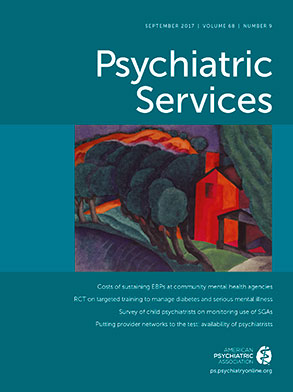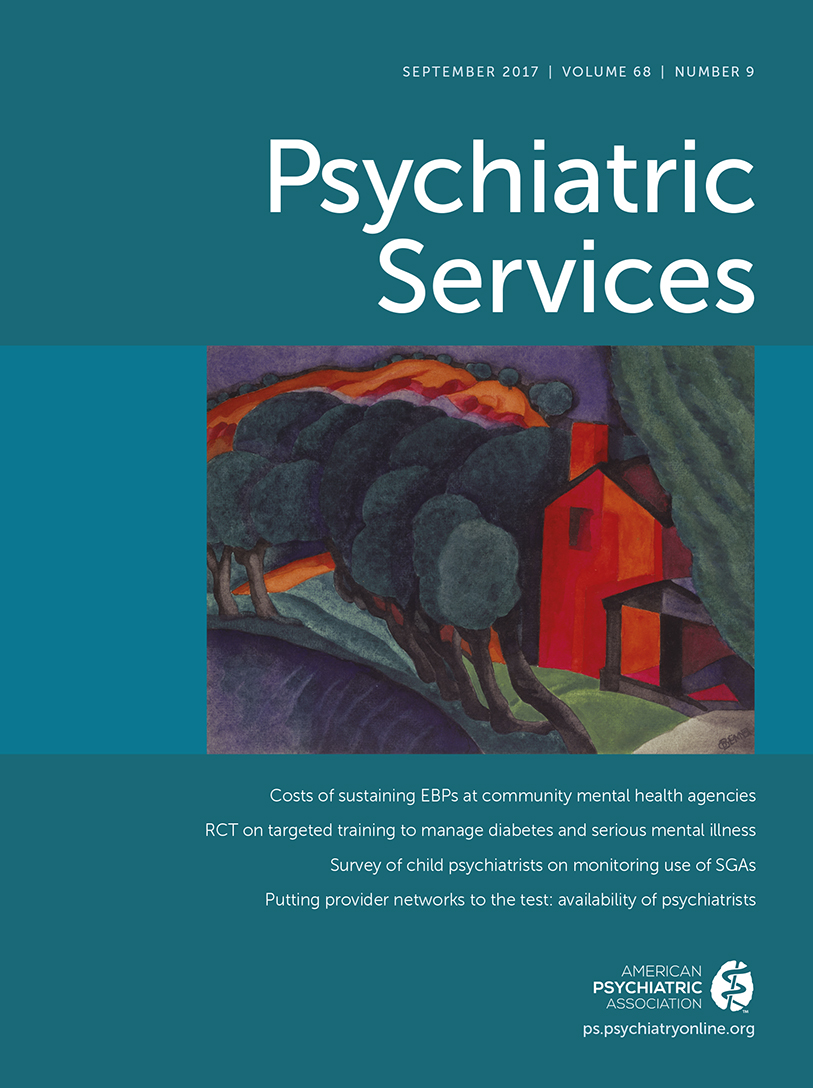It is widely agreed that shared clinical decision making (CDM) between patients and staff is an ethical obligation (
1,
2). A collaborative process of decision making contributes to high-quality, patient-centered health care (
3), and some evidence indicates that shared decision making in general medical settings has positive effects on treatment outcomes (
1,
4). Shared decision making may also reduce health care costs by reducing the use of ineffective or undesirable treatments (
5,
6). Research exploring decision making in mental health remains limited, especially in real-world psychiatric settings (
4). Involvement of mental health patients in decision making may increase engagement with services (
7) and medication adherence (
8), although findings remain equivocal (
1).
It is largely unknown whether preferences for or experiences of decision making have an impact on mental health service use. Therefore, this study examines decision making in routine psychiatric care for people with severe mental illness through an exploration of the relationship between preferences for and experiences of CDM with service use. Specifically, this study examined the following questions: Do preferences regarding participation in decision making influence service use and costs? Do preferences about the level of information provided affect service use? Does the level of involvement experienced in a clinical decision affect service use? Does satisfaction with an experienced clinical decision affect service use?
Methods
The “Clinical decision making and outcome in routine care for people with severe mental illness” study (CEDAR; ISRCTN75841675) (
9) was a prospective (2009–2012) observational study of routine psychiatric care in six European countries (Germany, United Kingdom, Italy, Hungary, Denmark, and Switzerland). Ethical approval was obtained from all participating centers. Patients and staff were recruited from outpatient or community-based mental health services. Patients ages 18–60 with any severe mental illness (a score of ≥5 on the Threshold Assessment Grid [
10] and illness duration of at least two years) and sufficient language proficiency were included. Exclusion criteria were a primary diagnosis of learning disability, dementia, substance misuse, or organic brain disorder; severe cognitive impairment; or treatment by forensic mental health services. Matched data were collected from a professional nominated by the patient.
The Client Sociodemographic and Service Receipt Inventory (
11) was used to assess use of community and outpatient mental health services, use of medication, and number and duration of inpatient stays. CDM preferences were measured with the Clinical Decision Making Style Scale (CDMS), which yields two subscales: participation in decision making (CDMS-PD) categorized as active (patient highly involved in the decision making), shared, or passive (patient has minimal input in the decision making); and level of information (CDMS-IN) provided, categorized as low, moderate, or high (
12). Involvement (CDIS-INV; classified as passive, active, or shared) and satisfaction (CDIS-SAT; low, moderate, or high) with a recently made decision was assessed by the Clinical Decision Making Involvement and Satisfaction Scale (CDIS) (
13). [More information on these measures is included in an
online supplement to this report.]
Data were analyzed with SPSS for Windows, version 23.0. Service use at baseline and at 12-month follow-up was compared using nonparametric Wilcoxon rank tests, and inpatient costs were compared with t tests. All baseline staff- and patient-rated CDMS and CDIS subscales were entered in binomial regression analyses as predictors of baseline service use. Multilevel models assessed predictors of changes in service use over time. All analyses controlled for age, gender, marital status, study site, diagnosis, and duration of illness.
Results
A total of 588 psychiatric outpatients participated, of whom 307 (52%) were women. Participants’ mean age was 41.7±10.7 years. The most common DSM-IV diagnoses were psychotic disorders (N=269, 46%) and mood disorders (N=200, 34%), and the mean±SD duration of illness was 12.5±9.30 years. Paired data for the 588 patients were obtained from 213 staff members; some staff members provided data for multiple patients. Of the staff members participating, data on profession were available for 206; 75 (37%) were psychiatrists, 19 (9%) were psychologists, 11 (5%) were social workers, and 101 (49%) were from another profession in the mental health service field. On average, staff had worked in mental health for 15.0±9.7 years.
At baseline, most patients and staff expressed a preference for shared decision making (patients, N=418, 71%; staff, N=115, 54%). Only 47 (8%) patients and 34 (16%) staff expressed a preference for active decision making, and 129 (22%) patients and 64 (30%) staff expressed a preference for passive decision making. The majority of patients reported a preference to receive a high level of information regarding decisions: high, N=359 (61%), moderate, N=206 (35%); and low, N=23 (4%). Staff preferences for information were high, N=75 (35%); moderate, N=121 (57%); and low, N=17 (8%).
When asked at baseline about the most recently experienced clinical decision, nearly half of all patients and staff reported that decision making had been shared (patients, N=292, 50%; staff, N=100, 47%). A total of 156 (27%) patients and 49 (23%) staff reported passive decision making, and 140 (24%) patients and 64 (30%) staff reported active decision making. Most staff and patients reported moderate or high satisfaction with the way in which the decision was made: high, 110 (52%) staff and 265 (45%) patients; moderate, 91 (43%) staff and 300 (51%) patients; and low, 12 (6%) staff and 23 (4%) patients.
Comparison of service use at baseline and 12-month follow-up showed that use of all types of services, except for inpatient treatment, remained stable over time. Number and duration of inpatient stays decreased significantly between baseline and 12-month follow-up (number, Z=−4.31, p≤.001; length, Z=−3.26, p≤.001) [see table in the online supplement]. Total costs of inpatient admissions also decreased significantly between baseline and follow-up (€2,512,330 versus €807,803; t=3.82, df=519, p≤001).
Table 1 presents data on the associations between patient- and staff-rated CDMS and CDIS with baseline service use. At baseline, a patient-rated preference on the CDMS-PD for an active style was associated with a higher number of inpatient stays compared with preferences for passive or shared CDM. The duration and costs of inpatient admissions were significantly predicted by all subscales, both staff and patient rated. Patient-rated preferences for passive or shared CDM style were associated with shorter admissions and lower costs compared with preferences for active CDM.
On the staff-rated CDMS-PD, preferences for shared CDM style were related to longer admissions. Staff preferences for passive CDM style were related to lower costs. For both patients and staff, a preference for a low level of information provision on the CDMS-IN predicted shorter admissions and lower costs, compared with a preference for a high level of information.
Similarly, for both patients and staff, passive patient involvement in a recent decision, as rated on the CDIS-INV, predicted shorter inpatient admissions, compared with active involvement, and passive and shared CDIS-INV predicted lower costs. Patient-rated low satisfaction on the CDIS-SAT predicted longer inpatient admissions and increased costs. Other service use variables were not associated with the CDMS or CDIS.
Predictors of significant changes in service use were also examined. An increase in the number of inpatient admissions over 12 months was associated with a patient-rated preference for active decision making (β=.236, df=353, p=.043) and a staff-rated preference for shared decision making (β=.181, df=353, p=.028). Longer inpatient admissions were predicted by a staff-rated preference for shared decision making (β=5.49, df=706, p=.030). Increased costs over the 12 months were predicted by low patient-rated satisfaction (β=4,803, df=752, p=.005).
Discussion
This study contributed to the limited data on the association of CDM and mental health service use among persons with severe mental illness. Self-reported decision-making preferences and experiences at baseline were associated with the number and duration of inpatient stays and with associated costs at baseline and over 12-month follow-up. In particular, preferences for and experiences with active CDM were associated with higher costs and more inpatient stays.
The findings are consistent with a growing body of evidence suggesting that decision making in medical settings is associated with cost-effectiveness (
5,
6). The results of our study also imply that aspects of decision making are related to service use and costs. Specifically, preferences for and experiences of a passive or shared style of decision making, compared with an active style, were associated with fewer inpatient stays and costs. Although lower costs do not equate to cost-effectiveness, such findings are in line with observations in general medical settings that shared decision making could improve cost-effectiveness by improving treatment, which in turn reduces the need for hospital admissions (
3,
5). This finding may also reflect shared factors that influence both decision making and treatment outcomes. Patients’ belief about their own decisional capacity influences decision-making preferences (
14), with patients with less severe illnesses, who are less likely to have inpatient admissions, reported to prefer shared decision making (
1). Decision-making preferences and level of involvement in decisions may be markers for other factors, such as insight and illness severity, which are related to inpatient stays and costs. Our results showed that patients who preferred and experienced active CDM had more admissions. Thus future research should examine whether active CDM is a marker of patients who are less well or whether there is a causal association between active CDM and more admissions and higher costs.
Low patient satisfaction at baseline with a recently experienced decision was associated with longer admissions and higher costs at baseline, as well as an increase in costs over time. These findings highlight the importance of patient satisfaction. Results are in line with previous research suggesting that patient satisfaction with explanations offered by service providers is associated with service use among persons with severe mental illness (
15). It remains unclear whether satisfaction with actual decision making independently drives the association with costs and admissions or whether dissatisfaction is associated with poorer well-being and greater illness severity—and thus with higher costs. Given the relationship between satisfaction and service use, staff awareness of patients’ preferences and expectations would likely be valuable in enhancing patient satisfaction. The extent to which differences in preferences between patients and their treating clinicians affect experiences of CDM, especially patient satisfaction, warrants future exploration.
The findings lend support to the assertion that there is no relationship between preferred and experienced CDM and medication use in outpatient mental health settings, despite previous findings regarding medication adherence (
8). In addition, although engagement with services was not directly studied, outpatient service use may serve as a proxy indicator of engagement. In contrast to previous findings (
7), our results indicate that use of outpatient and community services was unrelated to CDM preferences and experiences. Thus our results suggest that decision making, at least among persons with severe mental illness, may be largely unrelated to engagement with outpatient services. These findings might reflect that other factors may contribute more to engagement with services, or that those agreeing to participate and who completed bimonthly questionnaires, may have already been highly engaged.
Some limitations should be noted. The majority of participants reported being highly satisfied with decision making, which may have limited the range of findings. Experienced involvement in decision making was assessed by a single item, which possibly may limit the conclusions that can be drawn. Relatedly, the scales used were developed and validated in the study sample, and the ability of the scales to differentiate between CDM experiences and preferences across settings and patient groups is unclear. In addition, only costs associated with inpatient admissions were assessed. The sample examined was heterogeneous, with mixed diagnoses and comorbidities, and patients were treated by different clinicians. The staff also had a variety of professional backgrounds. Although heterogeneity may limit the conclusions that can be drawn about the relationship between CDM preferences and experiences and service use, the real-world nature of the study increases the generalizability of the findings and builds on the recommendation for naturalistic CDM research (
2,
3).

